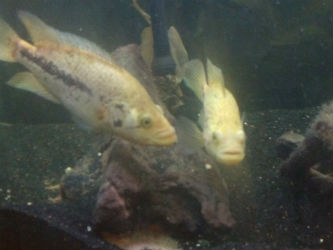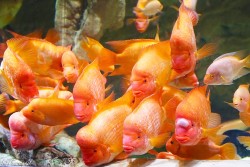Gold Jaguar Cichlid for Sale (Parachromis managuensis)
 The Jaguar Cichlid, scientifically known as Parachromis managuensis, is a remarkable and enigmatic species highly sought after by aquarists and fish enthusiasts alike. Named for its striking resemblance to the powerful and elusive jaguar, these cichlids are renowned for their captivating appearance and unique behaviors.
The Jaguar Cichlid, scientifically known as Parachromis managuensis, is a remarkable and enigmatic species highly sought after by aquarists and fish enthusiasts alike. Named for its striking resemblance to the powerful and elusive jaguar, these cichlids are renowned for their captivating appearance and unique behaviors.In this comprehensive guide, we will delve into the fascinating world of the Jaguar Cichlid, providing insights into their care, habitat, and maintenance in the aquarium setting.
Appearance and Coloration
Jaguar Cichlids live up to their namesake with a visually arresting appearance. They feature a robust and elongated body adorned with a striking pattern of dark, irregular spots and bars on a contrasting golden or yellow background. Their dorsal and anal fins extend impressively, giving them an imposing and predatory look.
Natural Habitat and Behavior
In the wild, Jaguar Cichlids are primarily found in Central America, inhabiting rivers, lakes, and slow-moving waters. They tend to favor environments with ample hiding spots such as submerged roots, rocks, and vegetation. Known for their assertive and territorial behavior, they are often solitary and fiercely protective of their territory, especially during breeding.
Creating the Perfect Habitat
To ensure the well-being of Jaguar Cichlids in your aquarium, consider the following:
1. Tank Size: Provide a spacious tank of at least 75 gallons to accommodate their size and territorial nature.
2. Substrate and Decor: Mimic their natural habitat with sandy or gravel substrates, and include plenty of hiding spots like caves, rocks, and driftwood.
3. Water Conditions: Maintain water parameters with a pH level of 6.5-7.5, a temperature range of 75-82°F (24-28°C), and clean, well-filtered water.
4. Tank Mates: Choose tank mates carefully, as Jaguar Cichlids can be aggressive, especially when breeding.
Feeding
Jaguar Cichlids are carnivorous predators and require a diet rich in protein. Feed them a variety of high-quality pellets, live or frozen foods such as fish, shrimp, and occasional treats like crickets to satisfy their predatory instincts.
Breeding and Reproduction
Breeding Jaguar Cichlids can be a rewarding but challenging endeavor due to their territorial nature. Here's how to approach breeding:
1. Pair Formation: Observe and select a compatible male and female. Provide hiding spots for the female to lay her eggs.
2. Courtship and Spawning: The male will display courting behaviors, and the female will lay eggs on a flat surface. Both parents guard the nest and fry.
3. Fry Care: After hatching, the fry can be fed with newly hatched brine shrimp and finely crushed flakes.
Frequently Asked Questions
What is the minimum tank size for keeping Jaguar Cichlids?
A tank of at least 75 gallons is recommended to provide adequate space for Jaguar Cichlids.
Are Jaguar Cichlids aggressive towards other fish?
Yes, they are territorial and can be aggressive, especially when breeding. Careful selection of tank mates is essential.
What is the ideal water pH range for Jaguar Cichlids in captivity?
Maintain a pH level between 6.5-7.5 for optimal Jaguar Cichlid health.
What should I feed my Jaguar Cichlid?
Offer a diet rich in protein, including high-quality pellets, live or frozen foods like fish and shrimp, and occasional treats like crickets.
How can I tell if my Jaguar Cichlids are ready to breed?
Look for courtship behaviors, including color changes and nest preparation. Provide suitable spawning sites to encourage breeding.
What is the typical lifespan of Jaguar Cichlids in captivity?
With proper care, they can live for 10-15 years in captivity.
Conclusion
The Jaguar Cichlid's stunning appearance and intriguing behaviors make it a captivating addition to aquariums for experienced fish keepers. By providing an appropriate habitat, understanding their dietary needs, and being mindful of their territorial nature, enthusiasts can enjoy the beauty and mystique of these remarkable fish in their home aquariums.
